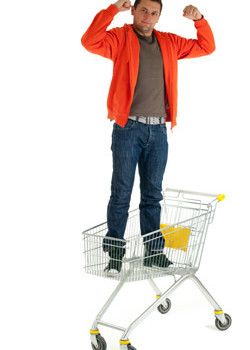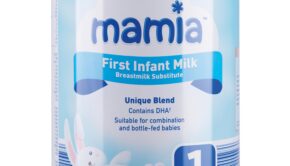Inside the mind of the Male Shopper

New research about men's shopping habits has been released by Shoppercentric detailing how they endeavor to get in and out of a shop as quickly as possible
16 December 2011
New research shows men are the “guided missiles” of the retailing world – determined to achieve “mission accomplished” status on any shopping trip with as little aggravation as possible. Gillian Hamill spoke to Shoppercentric MD Danielle Pinnington, to learn more about how grocers can appeal to these battle-weary customers
Stand-up comedians have long been able to rely on the differences between male and female shopping habits to raise a few giggles. Much mirth is made of the typical man’s bemusement when a woman searches for a new top in 10 different stores, before eventually returning to the first shop she visited and buying the very first item that she laid eyes on at the start of the day.
While this may be something of a retailing cliché, it is nevertheless grounded in reality. According to research conducted by UK-based shopper insight company, Shoppercentric, 49% of men agree that shopping is about getting in and out, compared to only 32% of women. What’s more, men visit fewer shops on a trip; 36% of men visit one to two stores per shopping trip, compared to only 23% of women.
‘Guided missiles’
In a new report on male shopping trends, Shoppercentric has developed a useful phrase to describe this phenomenon. Men are “the guided missiles” of the shopping world, they know what they want, and they want it as soon as possible. Whereas to many women, shopping is a kind of therapy, in contrast men view it more like a battlefield.
According to the researchers: “A typical male shopper might undergo a thorough reconnaissance phase, followed by stocking up with ammunition in the form of store and product lists, customer reviews, discount codes and promotions. After this comes the single-minded assault with the objective to return home with a purchase in a given amount of time. Too formulaic? Not according to our guys; the ultimate proof of a good shopping trip is mission completion.”
Given that men tend to want to get in and out of shops as quickly as possible, what can grocery stores do to provide an attractive retail environment for men? Shoppercentric’s managing director, Danielle Pinnington, tells ShelfLife that there are some “obvious things”grocers can do to achieve this aim. “Where there are categories that are specifically for men, retailers should make sure that they’re located somewhere that makes sense, and that isn’t causing issues. We often hear, ‘Why are the men’s toiletries right next to the sanitary items?’ There tend to be adjacencies that aren’t thought through; that can cause men a certain amount of embarrassment.”
Different rules for men
Within male-focused categories, fixtures should be “laid out as logically as possible” and the leading brands should be “very visible at the fixture”. Danielle explains: “Retailers are not attempting to interrupt men in the way that grocers always interrupt women. It’s playing different rules for men. That’s partly why I say it is a real challenge for the grocers, because on the whole they are selling mainly to women and it’s quite difficult for them to then take out particular areas of the store and treat them differently.”
An example of a male focused category that quickly springs to mind is the beers section. On this segment, Danielle says: “You’ve got gondola end offers, as well the offers in the aisle. Ideally, men want to find everything in one place rather than feeling they’ve got to check items around the store. Making sure that any promotions that are referenced elsewhere in the store are all within the beer aisle will also avoid any confusion, so that men know they can go to straight to the beer aisle and see every promotion that they want there”.
Achieving better loyalty among men
Working hard to make such categories appeal to men, will prove worthwhile according to Danielle, who says men tend to remain loyal customers once they find a store they like. “Retailers that are able to make that shift in presentation are likely to achieve better loyalty among men. Men, once they find a shop that works for them, they tend to stick to it; they’re not going to go elsewhere easily. They do become quite blinkered, and so if the store can work for them effectively then that’s the one that they will choose over and above others. There is certainly value in retailers thinking about this and an opportunity to get a greater share of the men who are out there doing grocery shopping.”
Given that men like to research at home before hitting the shopping battlefield in order to make their trip as swift and painless as possible, it’s not surprising that the Internet and new technologies have been eagerly adopted by men. So is this an area grocers can better utilise in order to entice more male customers to shop with them? Danielle replies that: “At the moment, men’s main focus is non grocery when they’re online, and it’s tending to be the women who are doing the online grocery shop. Over time, if men are completing more grocery tasks than their wives, it might well be men that push an online solution in the home.”
Technological solutions
As regards in-store technology, Danielle says solutions that “support the purchase process” can work but that retailers should be wary of adopting superfluous gizmos and gadgets. Shoppercentric highlights how Sainsbury’s supermarket trialled installing Ipad trolley docks in its Cromwell Road store, so that men could enjoy content such as football while shopping with their partners. “Technical initiatives can work for men, but it depends,” says Danielle. “The problem with that particular example, was that a man could push the trolley for his partner and watch the football on his Ipad, but it wasn’t actually supporting the purchase process. Whereas if technology is supporting the purchase process it can work; we know men are adopting Smartphone technology and playing with it, potentially quicker than women are. So things like QR codes which can be used to provide product information, we find men are utilising.”
Joined-up thinking
Given that men are goal-driven “guided missiles,” how then can grocers encourage them to be more impulsive and buy more than they possibly intended? According to Danielle: “Interestingly, men are almost as impulsive as women, even in grocery.” She believes the stereotype of women being good multi-taskers holds true, and that they can follow their shopping list while noticing offers throughout the store. Men, on the other hand, “are focused on their list and almost need to get their list achieved before they can take a step back and start noticing impulse triggers. The solution for men is about linking things.
“So if men are in the beer aisle, it’s about having clip strips of nuts for example or flagging up promotions to do with snacks in the beers aisle. I think the linked promotions are going to work more effectively for men, rather than just assuming that any promotion you put in will be of interest. They’re less likely than women to bounce around and to use gondola end promotions. They tend to be much more focused on getting their list sorted out and then taking a step back and noticing promotions. It’s not to say that they won’t do it because they are proving themselves to be as impulsive as women but it’s a different type of impulse”.
Locals and independents a hit with men
Another interesting finding revealed by the Shoppercentric study was that men tend to prefer local stores and independents over high street chains. Danielle explains: “The local independents tend to be better able to tailor their offer to the shoppers that are coming in. They also tend to serve them more effectively, in a way that appeals to men.
“A local retailer that owns their store and has that desire to make the store work, is much more able to suss out a shopper coming in and work out what they want and provide that service individually to that shopper and that really appeals to men,” says Danielle.
Are trained, knowledgeable sales people subsequently the key to impressing the male shopper? “I think that’s certainly a part of it but I think that for grocery, there’s also an issue to do with layout and with the way retailers communicate with men.” Avoiding clutter is imperative and grocers should communicate with men “in a much more functional way; alerting them to things rather than trying to be emotional in communication. They don’t need the extra fluff”.
In-store light and space are also important considerations for men. “Lots of units or sales bins littered around the store” will irritate men. “They like things quite ordered and neat and uncluttered, so plenty of space and light with a logical flow, works much better for them”.
Small is beautiful
When asked which stores provide a good example of delivering a male-friendly environment, Ireland is performing well in Danielle’s view. Within the UK, she sites the example of BP Connect, where M&S was introduced into the BP forecourt. “That puts two elements together brilliantly; the forecourt is a natural male environment and then you introduce very logical, cut down ranges so that men can dip in and dip out very quickly.
“I know Ireland has developed a lot of similar stores. Not necessarily those brands, but certainly I’ve seen examples of some very well ranged, stocked and designed forecourt stores in Ireland where the grocery section has high quality goods and fresh produce. That approach is a very different model to say 10 years ago in a forecourt area and it works very well for men”.
Men generally prefer small stores due to the ease with which they can be navigated. “They’ll go into the big shops, particularly if they’re going with their wives or their partners, but they have a preference for the smaller, less cluttered stores which are the ones that are emerging on the forecourt or the small formats, such as Tesco Express, Tesco Metro, and Sainsbury’s Local,” says Danielle.
When it comes to attracting men, convenience stores therefore appear to have a head start on the multiples due to their man-friendly size. Very good news for Ireland, considering the quality and high standards of our nation’s c-stores. n



 Print
Print






Fans 0
Followers